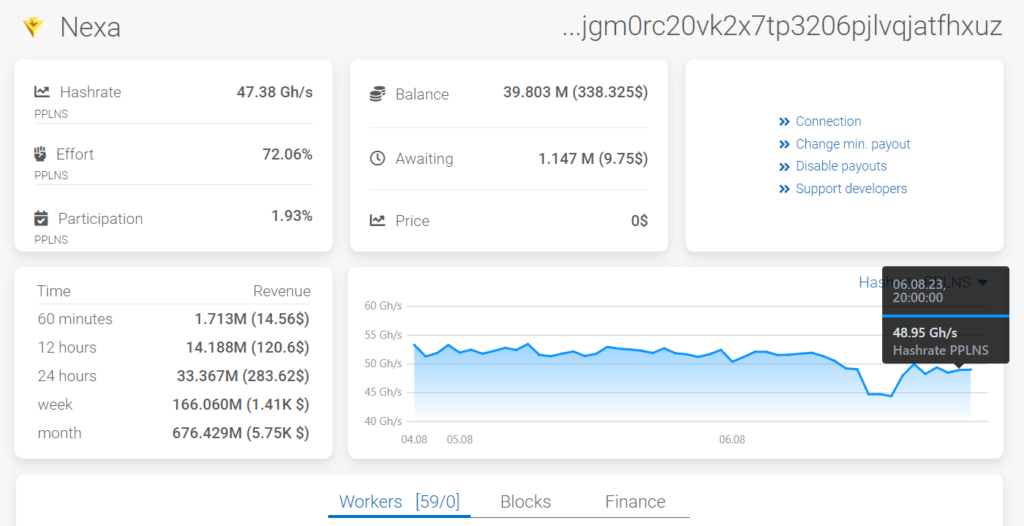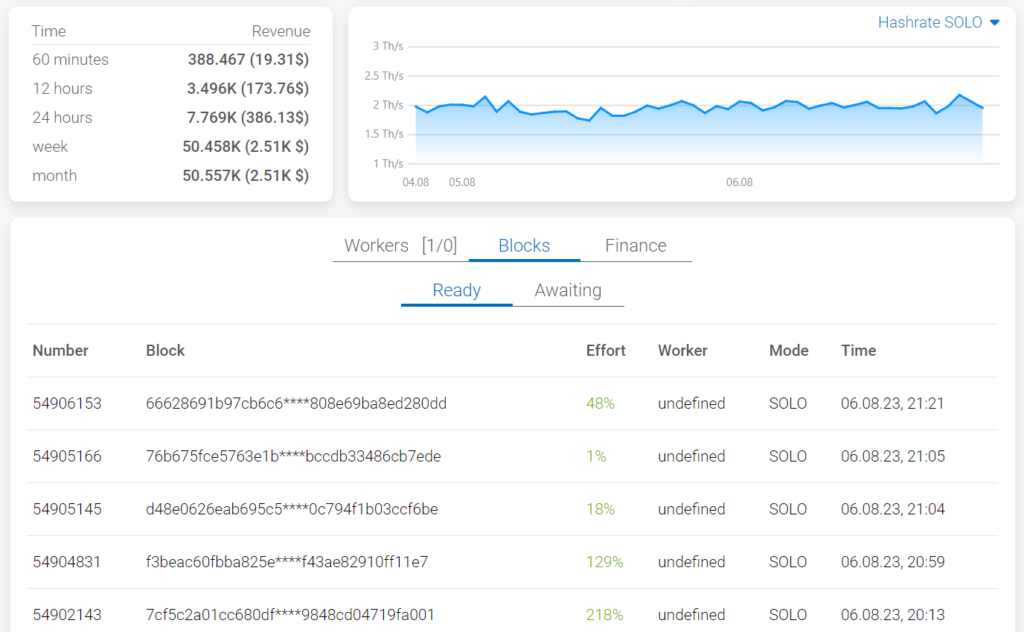In the ever-evolving landscape of cryptocurrency, understanding the nuances of mining reward systems can be a game-changer. PPLNS vs SOLO, two of the most debated methods, offer unique advantages and challenges. This article delves deep into these systems, helping miners make an informed choice. Let’s embark on this enlightening journey!
Understanding Crypto Mining Rewards
Cryptocurrency mining is a complex process that involves solving intricate mathematical problems to validate and record transactions on a blockchain. Miners, who are the backbone of this system, use their computational power to solve these problems. As a reward for their efforts and the resources they expend, they receive cryptocurrency coins. This reward system is not just a coin of appreciation but a crucial incentive mechanism that ensures the security and functionality of decentralized cryptocurrency networks.
Why Do Mining Rewards Exist?
The concept of mining rewards was introduced to incentivize individuals to participate in the mining process. Without these rewards:
- There would be little motivation for miners to invest in the expensive hardware required for mining.
- The security of the blockchain could be compromised, as fewer miners would mean a higher chance of a single entity gaining control over the majority of the network’s computational power, leading to potential attacks.
Types of Mining Rewards
There are primarily two types of mining rewards:
- Block Rewards: This is the primary incentive for miners. Whenever a miner successfully solves a block (i.e., validates and records a set of transactions on the blockchain), they receive a predetermined number of cryptocurrency tokens. This number can vary based on the cryptocurrency and can decrease over time, as seen with Bitcoin’s halving events.
- Transaction Fees: Apart from the block reward, miners also receive the fees associated with each transaction they validate. As the block rewards decrease, these transaction fees become increasingly significant.
Reward Distribution Methods
How these rewards are distributed among miners can vary based on the mining method they choose. Two of the most popular methods are PPLNS and SOLO, each with its own set of advantages and challenges. For a deeper dive into these payout schemes and others, check out this comprehensive guide.
What is PPLNS?

PPLNS, an acronym for “Pay Per Last N Shares,” is one of the most popular reward distribution methods used by mining pools. It’s designed to offer a more equitable payout system for miners based on their contribution to the pool over a specific period. Let’s delve deeper into the intricacies of PPLNS and understand its workings, benefits, and potential drawbacks.
Definition and Full Form
PPLNS stands for “Pay Per Last N Shares.” In the context of cryptocurrency mining, a “share” represents a miner’s computational effort towards finding a new block. The “N” in PPLNS refers to the number of shares considered for the payout, which can vary from one pool to another.
How PPLNS Works
- Joining the Pool: Miners collaborate by joining a mining pool to combine their computational power, increasing the chances of successfully mining a block.
- Contribution of Shares: As miners work on solving cryptographic problems, they submit shares to the pool as proof of their work.
- Reward Distribution: When the pool successfully mines a block, the reward is distributed among miners based on the last N shares they contributed. This means that if a miner contributed more shares in the recent past, they would receive a larger portion of the reward.
Benefits of PPLNS
- Fairness: PPLNS rewards consistent contributors. Those who mine regularly and contribute shares over time tend to benefit more than sporadic participants.
- Protection Against Pool Hopping: Some miners try to exploit reward systems by “hopping” between pools to maximize their rewards. PPLNS reduces the profitability of such strategies, ensuring more stable and consistent payouts for loyal miners.
- Reduced Variability: While the rewards in PPLNS might fluctuate, they are generally more consistent over time compared to other methods like SOLO mining, where the rewards can be highly unpredictable.
Drawbacks of PPLNS
- Initial Delay: New miners might experience a delay in receiving their first payout since the system considers only the last N shares. It might take some time for a new miner to contribute enough shares to be eligible for a significant reward.
- Fluctuating Rewards: The rewards in PPLNS can vary based on a miner’s recent contributions. If a miner’s contribution drops, so will their reward, even if they were previously a significant contributor.
What is SOLO Mining?

SOLO mining, as the name suggests, refers to the practice where individual miners operate independently, relying solely on their computational power to discover new blocks and claim rewards. Unlike pooled mining where multiple miners combine their resources, SOLO miners bear the entire risk and potential reward of mining. Let’s explore the intricacies of SOLO mining, its advantages, and the challenges it presents.
Definition
SOLO mining is the traditional form of cryptocurrency mining where a miner uses their own hardware resources to solve complex cryptographic problems without joining a mining pool. If they successfully discover a new block, they receive the entire block reward along with the transaction fees from that block.
How SOLO Mining Works
- Setup: Miners configure their mining software to connect directly to the blockchain of the cryptocurrency they wish to mine.
- Mining Process: Using their computational power, miners attempt to solve cryptographic puzzles. The complexity of these puzzles adjusts over time to ensure that blocks are discovered at a relatively consistent rate.
- Block Discovery: If a SOLO miner successfully solves a puzzle and discovers a new block, they broadcast it to the network for verification.
- Claiming Rewards: Once the block is verified and added to the blockchain, the miner receives the entire block reward and any associated transaction fees.
Benefits of SOLO Mining
- Full Rewards: The most significant advantage of SOLO mining is the potential to claim the entire block reward. There’s no need to share rewards with other miners, as is the case in pooled mining.
Drawbacks of SOLO Mining
- High Variability: The chances of discovering a block as a SOLO miner, especially in popular cryptocurrencies like Bitcoin, are relatively low. This means miners can go extended periods without earning any rewards.
- Resource Intensive: SOLO mining can be resource-intensive, requiring significant electrical and computational power. The costs can quickly add up, especially if rewards are infrequent.
- No Consistent Income: Unlike pooled mining, where miners can expect more regular (albeit smaller) payouts, SOLO mining is highly unpredictable. Miners might earn a substantial reward one month and nothing the next.
PPLNS vs SOLO: A Comparative Analysis
To help miners make an informed decision, let’s delve into a detailed comparative analysis of PPLNS vs SOLO.
| Criteria | PPLNS | SOLO |
|---|---|---|
| Reward Distribution | Rewards are distributed based on a miner’s contribution to the last N shares in a pool. | The miner who successfully discovers a block receives the entire block reward. |
| Payout Frequency | More consistent and regular payouts due to collective efforts of the pool. | Highly unpredictable. Miners can go long periods without rewards but receive large payouts when successful. |
| Risk Level | Lower risk as rewards are more consistent, but potential reward per block is lower. | Higher risk due to the unpredictability of discovering a block, but potential for higher rewards. |
| Resource Requirement | Suitable for miners with varying computational power, from low to high. | Best suited for miners with significant computational power due to the high competition in block discovery. |
| Impact on Crypto Network | Promotes decentralization as more miners can participate and earn rewards. | Can lead to centralization if a few powerful miners dominate block discoveries. |
Real-world Case Studies. SOLO Mining vs Pool Mining
The theoretical differences between PPLNS and SOLO mining are evident, but real-world scenarios can offer a clearer picture of the practical implications of choosing one method over the other. Let’s delve into two case studies that highlight the experiences of miners who opted for PPLNS and SOLO mining.
Case Study 1: Alex’s Journey with PPLNS

Background: Alex, a software engineer with a keen interest in cryptocurrencies, decided to venture into crypto mining. With a modest setup comprising a couple of high-end GPUs, he realized that competing in the SOLO mining arena against mining farms would be challenging.
Decision to Choose PPLNS: Given his limited computational power, Alex joined a Nexa PPLNS pool to increase his chances of earning rewards. He was attracted to the idea of more consistent payouts and the collaborative spirit of pooled mining.
Experience:
- Consistent Rewards: Over six months, Alex received regular payouts, albeit smaller than block rewards. These consistent earnings motivated him to continue mining.
- Community Support: Being part of a pool, Alex benefited from the shared knowledge and support of fellow miners, helping him optimize his mining setup and strategy.
Outcome: After a year, Alex’s earnings from the PPLNS pool, combined with the appreciation of the mined cryptocurrency, provided a decent return on his investment. The consistency and community support reaffirmed his decision to opt for PPLNS.
Case Study 2: Grace’s SOLO Mining Adventure

Background: Grace, an IT entrepreneur with access to substantial computational resources, was intrigued by the allure of crypto mining. With a robust setup of multiple Kaspa ASIC miners, she believed she had a competitive edge.
Decision to Choose SOLO Mining: Grace was enticed by the prospect of earning entire block rewards without sharing. She was willing to embrace the unpredictability of SOLO mining in hopes of higher returns.
Experience:
- Initial Drought: The first three months were challenging. Despite her powerful setup, Grace couldn’t mine a single block, leading to doubts and concerns about her investment.
- The Big Break: In the fourth month, Grace successfully mined two blocks in quick succession. The combined rewards from these blocks significantly outweighed the potential earnings from a PPLNS pool during the same period.
- Resource Management: Grace had to invest time in managing and optimizing her crypto mining rigs, ensuring they operated efficiently. The absence of a pool community meant she had to rely on online forums and her research.
Outcome: By the end of the year, Grace had mined a total of five blocks. The rewards, combined with the value appreciation of the cryptocurrency, provided a substantial return. However, the journey was marked by periods of uncertainty and the constant need for optimization.
Case 3: The Underdog Solo Miners

Background: In the competitive world of Bitcoin mining, where large mining farms with enormous computational power dominate, a few solo miners have defied the odds, making headlines with their unexpected successes.
- The 10 TH/s Wonder: A miner, with a hash rate of just 10 TH/s, managed to solve a Bitcoin block, an event that was covered by Decrypt. This feat was remarkable given the extremely unlikely odds of such a low hash rate achieving success in the vast Bitcoin network.
- The $148K Reward: Another solo miner, deemed ‘very lucky‘ by the crypto community, solved a Bitcoin block and earned a whopping $148K reward. This event was also highlighted by Decrypt, showcasing the high-risk, high-reward nature of SOLO mining.
- Pocket Mining: An article from Blockworks discussed the feasibility of mining Bitcoin from one’s pocket for less than $400. It highlighted that solo mining can work, albeit rarely, and successful miners can recoup a significant portion of their investments.
- Defying Massive Odds: A Cointelegraph article detailed the story of a tiny Bitcoin miner who managed to solve a valid block, once again emphasizing the unpredictability and potential rewards of SOLO mining.
Outcome: These real-world cases underscore the unpredictability of SOLO mining. While the chances of success are slim, especially for miners with limited resources, the potential rewards can be substantial. These miners, with their unexpected successes, serve as inspirations for many in the crypto community, proving that with persistence, even the underdogs can have their day.
Making the Right Choice
Both PPLNS and SOLO mining have their merits, but the best choice often boils down to individual circumstances and goals. Let’s explore the factors to consider when making this pivotal decision.
Assessing Your Resources
- Computational Power: The first step is to evaluate the strength of your mining setup. If you have one or two mining rigs, joining a PPLNS pool might be more beneficial as it offers more consistent rewards. On the other hand, if you possess a powerful setup with multiple high-end rigs or ASIC miners, venturing into SOLO mining could be a viable option.
- Financial Investment: Consider the amount you’re willing to invest in mining hardware, electricity, and other associated costs. PPLNS pools often have fees, but they can provide more stable returns. SOLO mining might have higher potential rewards, but it also comes with longer periods of no returns, which can strain your finances.
Understanding Your Risk Appetite
- Stability vs. High Rewards: Are you someone who prefers consistent, smaller rewards or the thrill of potentially hitting a jackpot? PPLNS offers the former, with more regular payouts, while SOLO mining is a high-risk, high-reward venture.
- Long-Term Commitment: SOLO mining requires patience and a long-term perspective, as there might be extended periods without rewards. If you’re looking for quicker returns or lack the patience for SOLO’s unpredictability, PPLNS might be a better fit.
Market Dynamics and Cryptocurrency Choice
- Cryptocurrency Popularity: Mining popular cryptocurrencies like Bitcoin SOLO can be extremely competitive, making it challenging for individual miners to earn rewards. In such cases, joining a pool might be more practical.
- Network Difficulty: As more miners join a cryptocurrency network, the difficulty of mining increases. Regularly assess the network difficulty of your chosen cryptocurrency to determine if SOLO mining remains feasible or if it’s time to consider a pool.
Community and Support
- Learning Curve: If you’re new to mining, being part of a PPLNS pool can offer valuable insights, shared knowledge, and community support. This can be crucial in understanding best practices and troubleshooting issues.
- Independence: If you’re a seasoned miner or prefer autonomy, SOLO mining allows you to operate independently, making decisions without the constraints of a pool’s rules or fees.
Future-Proofing Your Decision
- Stay Updated: The world of cryptocurrency is dynamic. Regularly update yourself on market trends, technological advancements, and changes in network difficulty.
- Flexibility: Don’t hesitate to re-evaluate your decision as circumstances change. Whether it’s shifting from SOLO to PPLNS or vice versa, or even exploring hybrid models, always be ready to adapt.
Conclusion
The exploration of PPLNS and SOLO mining methods, illustrated through real-world case studies and detailed analysis, paints a vivid picture of the multifaceted world of cryptocurrency mining.
Cryptocurrency mining is not a one-size-fits-all endeavor. The choice between PPLNS and SOLO mining is influenced by a myriad of factors, including individual resources, risk appetite, the chosen cryptocurrency, and even personal values and aspirations. The stories of Alex, Grace, and the underdog solo miners demonstrate that success in mining is not merely about choosing the “right” method but about aligning one’s approach with personal circumstances and goals.
The world of mining is not just about algorithms and rewards. It’s a community-driven space where collaboration, shared knowledge, and support play vital roles. Whether it’s the camaraderie in a PPLNS pool or the online forums that guide solo miners, the human aspect of mining is as crucial as the technicalities.
FAQs
Is PPLNS better than SOLO for beginners?
Yes, PPLNS offers more consistent rewards and is generally recommended for those starting their mining journey.
Can I switch from SOLO to PPLNS anytime?
Absolutely! Miners can switch based on their preferences and market conditions.


